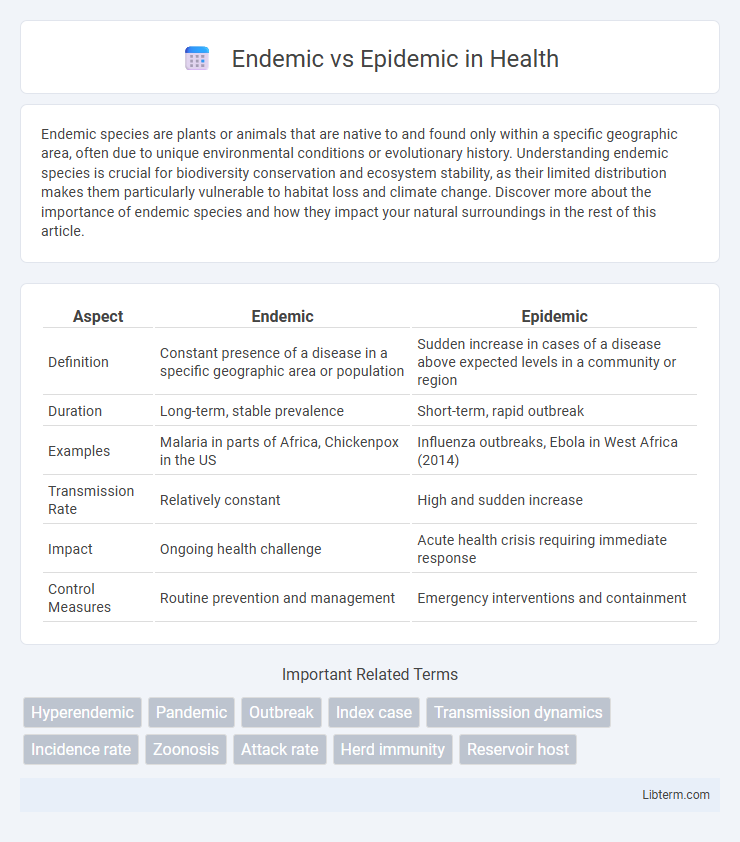Endemic species are plants or animals that are native to and found only within a specific geographic area, often due to unique environmental conditions or evolutionary history. Understanding endemic species is crucial for biodiversity conservation and ecosystem stability, as their limited distribution makes them particularly vulnerable to habitat loss and climate change. Discover more about the importance of endemic species and how they impact your natural surroundings in the rest of this article.
Table of Comparison
| Aspect | Endemic | Epidemic |
|---|---|---|
| Definition | Constant presence of a disease in a specific geographic area or population | Sudden increase in cases of a disease above expected levels in a community or region |
| Duration | Long-term, stable prevalence | Short-term, rapid outbreak |
| Examples | Malaria in parts of Africa, Chickenpox in the US | Influenza outbreaks, Ebola in West Africa (2014) |
| Transmission Rate | Relatively constant | High and sudden increase |
| Impact | Ongoing health challenge | Acute health crisis requiring immediate response |
| Control Measures | Routine prevention and management | Emergency interventions and containment |
Understanding Endemic and Epidemic: Key Definitions
Endemic refers to the constant presence and usual prevalence of a disease within a specific geographic area or population, exemplified by malaria in parts of Africa. Epidemic describes a sudden increase in the number of disease cases above the expected baseline in a particular region, such as the 2014 Ebola outbreak in West Africa. Understanding these terms helps public health officials implement targeted interventions and allocate resources effectively.
Core Differences Between Endemic and Epidemic
Endemic refers to the constant presence and usual prevalence of a disease within a specific geographic area or population, maintaining a steady state without causing widespread outbreaks. Epidemic describes a sudden increase in the number of disease cases above the normal expected level in a particular region or population, often leading to rapid transmission and heightened public health concerns. The core difference lies in the baseline occurrence; endemic diseases persist at predictable levels, while epidemics represent unexpected spikes demanding urgent intervention.
Causes Behind Endemic Diseases
Endemic diseases persist within a specific geographic area or population due to consistent environmental, biological, and social factors that support their continuous presence. Causes behind endemic diseases include stable pathogen reservoirs such as animal hosts or contaminated water sources, climatic conditions favoring vector survival, and limited immunity among the local population. These factors create a balanced disease-host relationship, making the infection predictable and recurrent in the affected region.
Factors Leading to Epidemic Outbreaks
Rapid population density increases, pathogen mutation rates, and compromised immunity are primary factors leading to epidemic outbreaks, causing diseases to spread beyond expected geographic areas. Environmental changes, such as deforestation and urbanization, disrupt natural hosts and vectors, facilitating the emergence of new epidemic patterns. Inadequate public health infrastructure and delayed response exacerbate transmission, intensifying the scale and impact of epidemics compared to endemic diseases.
Examples of Endemic Diseases Worldwide
Malaria remains endemic in many tropical regions of Africa, Asia, and Latin America, with millions of cases reported annually due to stable transmission by Anopheles mosquitoes. Tuberculosis is endemic in parts of India, China, and South Africa, where the disease persists at steady rates despite extensive public health efforts. Another example includes dengue fever, which is endemic to Southeast Asia and the Pacific Islands, marked by consistent outbreaks and sustained presence in these areas.
Notable Epidemics in Recent History
Notable epidemics in recent history include the 2014-2016 Ebola outbreak in West Africa, which caused over 11,000 deaths, and the H1N1 influenza pandemic in 2009 affecting nearly 700 million people globally. The Zika virus epidemic in 2015-2016 spread rapidly across the Americas, leading to thousands of birth defects linked to the infection. These outbreaks exemplify the rapid and widespread impact of epidemics compared to endemic diseases, which persist at a steady state within populations.
Transmission Patterns: Endemic vs Epidemic
Endemic diseases maintain a constant presence within a specific geographic area or population, characterized by steady transmission rates and predictable patterns. Epidemic outbreaks occur when the transmission rate of a disease rapidly escalates above the expected baseline, often spreading quickly through susceptible populations. Understanding transmission dynamics is crucial for public health strategies to control endemic stability or to contain and mitigate epidemic surges.
Public Health Strategies for Endemics
Public health strategies for managing endemic diseases prioritize sustained interventions such as continuous surveillance, vaccination programs, and community health education to maintain infection rates at manageable levels. Resources are allocated to strengthen local healthcare infrastructure and implement routine monitoring to detect any abnormal increases in cases early. Targeted efforts focus on reducing transmission through improved sanitation and promoting behavior changes tailored to the specific disease and population.
Epidemic Response and Control Measures
Epidemic response and control measures focus on rapid identification, containment, and mitigation to prevent widespread transmission of infectious diseases. Key strategies include widespread testing, contact tracing, quarantine protocols, vaccination campaigns, and public health communication to reduce infection rates and healthcare system strain. Effective epidemic management relies on coordinated efforts between government agencies, healthcare providers, and communities to implement surveillance systems and resource allocation swiftly.
Implications for Future Disease Management
Understanding the distinctions between endemic and epidemic diseases is crucial for tailoring future disease management strategies, as endemic diseases require sustained, long-term public health interventions focused on control and prevention within specific populations. Epidemic diseases demand rapid response mechanisms, including outbreak detection, resource mobilization, and containment measures to mitigate widespread transmission. Integrating real-time data analytics, vaccine development, and community engagement enhances preparedness for both endemic persistence and epidemic surges.
Endemic Infographic

 libterm.com
libterm.com